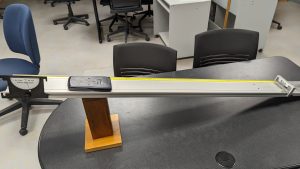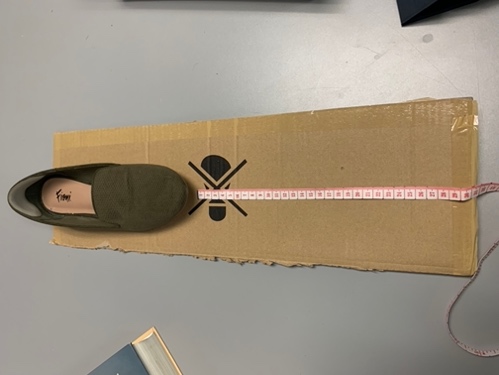Exercise 3: Measuring coefficient of kinetic friction
In the next part of this lab you will use the average angle of your ramp that you found in Exercise 2. This will let you determine the coefficient of kinetic friction, 𝝁k.
Procedure:
Set up your shoe and ramp like you did in Exercise 2. Place your ramp at the average angle you measured in Exercise 2.
Place your shoe at the top of your ramp and measure the length the shoe will slide. This should be from the toe of your shoe to the edge of the ramp as shown in the image below. The longer the ramp, the more accurate your results will be.
In the lab:

At home:

Release your shoe from the top of the ramp and time how long it takes to slide to the end. Please see the video below for extra guidance if needed.
Repeat the above three steps two more times and record the angle, length of ramp, and time in the results table shown below. Make sure to always remeasure and readjust the angle between trials. Note: Leave the coefficient of kinetic friction (𝝁k) and acceleration (a) columns blank for now. You will be calculating both in the next section.
In the lab:
At home:
Exercise 3.1 (1 mark)
Submit a photograph of your experimental set-up including your shoe (or calculator) and your ramp, with the student card(s) of the member(s) participating in this lab clearly visible.
Secondly, provide an additional image of the student cards used in the previous photo. Here, the student name(s) and student number(s) must be legible. With your experimental set up in the background, you may take this image from a closer view to ensure the student card(s) is/are in full focus. Note: You do not need to be in the photo. If you are completing this lab with others virtually, you may provide a screenshot of your video call, with the student cards of all members visible. Your experimental set up must still be visible in the background.
Results
Coefficient of Kinetic Friction Data

Analysis
Exercise 3.2 (1 mark)
Exercise 3.3 (1 mark)
Exercise 3.4 (2 marks)
Before you continue!
Before continuing, be sure you have completed (3.1) to (3.4), which will be graded and submitted through Crowdmark.

